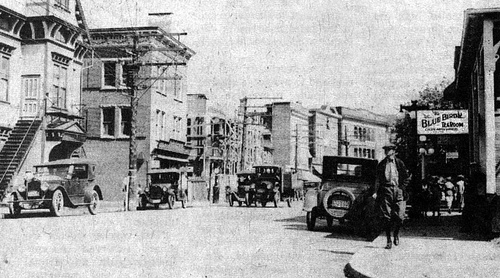 The sign for the Blue Bird Tea Room can be seen at right. (c. 1924)
The sign for the Blue Bird Tea Room can be seen at right. (c. 1924)
Main Street at the corner of River Street, from left, the old Town Hall, Walton and Tousley, the Tousley Building under construction, Little Joe's, the Donaldson Block, and the Haase Block are all visible. (Adirondack Daily Enterprise, undated clipping) "Tea rooms" became popular early in the 20th century. They were originally associated with the women's independence movement, as at the turn of the century, tea-rooms in hotels and department stores were among the few public places unescorted women could go for refreshment.
The restaurant business was closely associated in many people’s minds with catering to appetites of all kinds, including sexual appetites. For a woman to enter this business at the turn of the century, even as an unescorted patron, was a risk to her reputation…Women’s exclusion from many public dining rooms in the 1900s and 1910s was undoubtedly a factor in their attraction to female-friendly tea rooms. Most women were reluctant to challenge the widespread rule in hotels and fine dining rooms that unescorted women would not be served...
Hotel tea rooms were managed by men for the most part, but the small independent tea rooms that began in the 1910s were usually owned, operated and fully staffed by women, often times middle-class women…Because men would not work under the command of a woman, the owners had little choice but to hire all-women staffs — quite a novelty. (Jan Whitaker, Tea At The Blue Lantern Inn A Social History of the Tea Room Craze in America)
Originally associated with the temperance movement, some tea rooms came to serve alcohol in Prohibition years.
The Saranac Lake area had several tea rooms, and it is difficult to distinguish the dry from the wet.
Lake Placid News, March 28, 1919
SUBSTITIUTING THE BARROOM
Relative to the problem of providing congenial meeting places for those who patronized the saloons, the Saranac Lake News says: It may be as speakers often assert, the “duty” of the temperance forces who have overthrown the liquor traffic, to provide a substitute for the "poor man's club" that the barroom has undoubtedly been, a place of entertainment and a meeting place in the stead of that which is being taken away. But if it is a duty, it is one that the temperance forces will fail in performing. No proposed substitute that has about it any element of charity can possibly succeed. The substitute for the bar, like the bar itself, will be a commercial proposition which a self-respecting man will be able to feel that he is paying his way That was one secret of the bar-room's success. Its patrons were there by no man's favor, but of right, and all the elaborate schemes for reading rooms, tea rooms, and the like, to be supervised by and regulated by self-elected moral guardians and furnishing a service at cost or less, may as well be discarded at the outset. They will fail to attract the patronage of the men who went to bars because they found there a pleasant companionship and a form of amusement to their liking. They will fail because of a fundamental element of human nature.
Malone Farmer, July 9, 1919
Katherine Brown Potter, who is conducting “The Algonquin” this season at Saranac Lake, has converted the bar and grill into a tea room where sandwiches, cakes, ice cream and other light refreshments are served.
Lake Placid News, August 12, 1921
FOR SALE—A FINE TEA ROOM
and restaurant completely equipped in fine location and with all modem and up-to-date furniture and utensils. Wonderful opportunity to right person to take over at once. Can be had cheap and on easy terms. Apply Francis B. Cantwell, Attorney-at-law, Saranac Lake, N. Y.
Lake Placid News, September 15, 1922
…Another outgrowth of the present season is the increasing number of roadhouses of the better sort, catering to the traveling motorists. The tea rooms have also increased in number, and many of them are within motoring distance of larger villages, making it attractive to the resident as well as the tourist…



